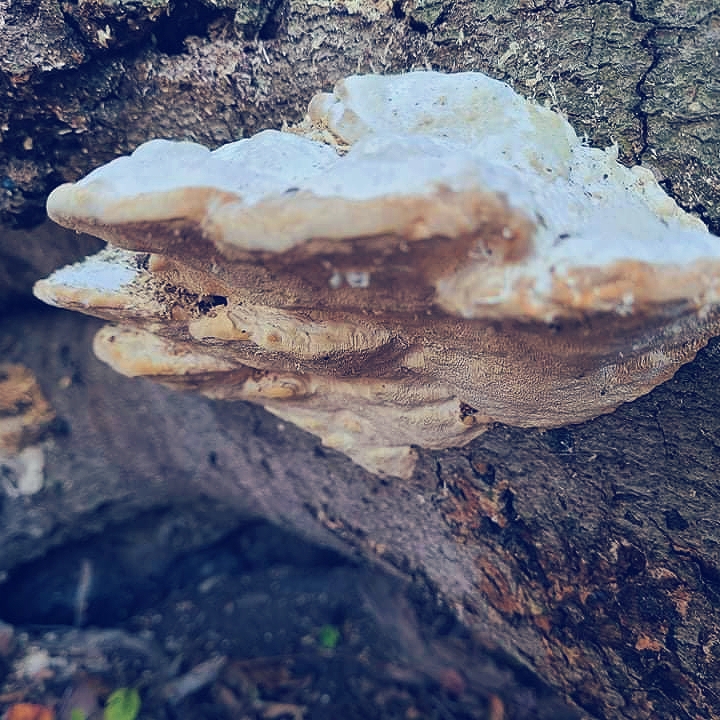I don’t like Black Friday. Part of it comes from several years of retail work, part of it comes from reading way too many stories of people getting shanked over Elmo dolls and discount TVs. It sucks for workers, it sucks for shoppers, it just sucks all around.
So, when a Meetup group I’m in posted a late afternoon hike this past Friday, I was more than happy to do that. The weather didn’t look promising, but there’s no such thing as bad weather — just the wrong clothes. As long as it kept me from being bombarded with reminders of Black Friday, I would’ve hiked in a storm.
This came right after a Zoom session about the role of walking as a spiritual practice. It was a really enjoyable discussion, and I was intrigued by the number of different roles it seems to occupy for people. I never really gave walking much thought — it’s part of my spiritual practice, but not one I really had to devote brainspace to, if that makes sense. Some talked about entering a kind of flow state, where the walk itself was a way to disconnect from the body. For others, walking was the opposite — a chance to focus on mindful movement, and quiet the mind. It all depends on what you need from it. Will walking be an external practice, or an internal one?
For me, it’s always been a weird form of augury. I don’t want to use the phrase “connect with nature,” because I feel like the wellness movement has worn it pretty thin. Really, it’s a way to make friends, as long as your definition of “friends” is flexible enough to include fungi and holes in the ground. If I meet a lot of new friends, it’s a pleasant walk and a good omen. If I don’t, it isn’t.
It can be a more specific divinatory practice, too. I know it’s not uncommon for people experiencing a lot of synchronicities (angel numbers, and the like) to ask for a sign or some kind of answer. Asking for one, then going out for a walk to see what you get is a useful form of divination. It’s definitely easier than trying to find a haruspex in this day and age.
It’s also a gratitude practice for me. I’m not about to get all gratitude journal on you, but, after spending several years too sick and deconditioned to do much of anything, I feel like the best way to express thanks for still having a mostly-functioning body is to use it for stuff.
We started out by meeting up in a parking area near one of the picnic groves. (There are trails all over this area, so you can pretty much start walking in any direction and end up on one.) It was really good to finally meet some of the people I’d only be able to speak to on Zoom calls, and the hike itself wasn’t too tough — three miles start to finish, through trees that helped cut some of the blustery wind and whose leaves lit up like lanterns once the sun sank below the lead-colored clouds. The air was scented with the vaguely spicy smell of gently decaying leaves, and so cold that I could feel it like a razor every time I reached the top of a hill.
Which is exactly how I ended up having to stop and catch my breath a bunch of times, wrestling with my jacket to pull out the carton of warmish coconut water I’d kept snuggled against my chest like a newborn. Fortunately, I brought a bandana-style mask with me. It helped warm the air before I breathed it in, which made things a bit easier, and also allowed me to pretend to be normal while actually gasping like a malfunctioning Billy Bass.
The entire forest is slowed down for the cold seasons, so it wasn’t like hiking earlier in the year. While the moss was still green, it was confined to neat, short little mats without their long, almost eerie-looking spore capsules. There were no eyelash cups or jack-o-lantern mushrooms. I did spot some neat-looking shelf fungi, and scrambled down into a space under a fallen tree for a picture. Another branch held some tiny specimens that were so fine and woody, they almost looked like ruffled feathers.


We all made it to the end, just before sunset. The light had that “golden hour” magic going on, which turned the treetops and patches of sky into a stained-glass canopy and the fallen leaves into a blanket of gold and copper. There was a peaceful moment where we paused before leaving, to make offerings of water and close out the experience. My partner and I picked up tea and dinner, then headed home.
It was the longest uninterrupted hike I’d been able to do in years. It gave me a chance to push my limits a bit more, and feel the edge of where my endurance is now. I get winded and dizzy easier than I did before IH, but I did it, and I’m intensely happy and grateful.
A good walk, and a good sign.







